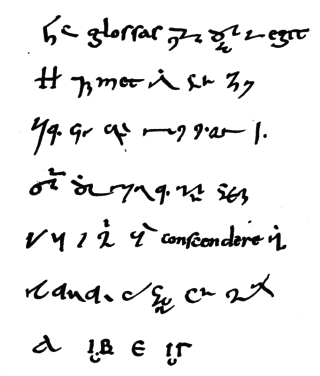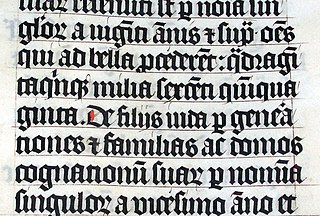An abbreviation is a shortened form of a word or phrase, by any method including shortening, contraction, initialism or crasis.

X, or x, is the twenty-fourth letter of the Latin alphabet, used in the modern English alphabet, the alphabets of other western European languages and others worldwide. Its name in English is ex, plural exes.

English plurals include the plural forms of English nouns and English determiners. This article discusses the variety of ways in which English plurals are formed from the corresponding singular forms, as well as various issues concerning the usage of singulars and plurals in English. For plurals of pronouns, see English personal pronouns.

Shorthand is an abbreviated symbolic writing method that increases speed and brevity of writing as compared to longhand, a more common method of writing a language. The process of writing in shorthand is called stenography, from the Greek stenos (narrow) and graphein. It has also been called brachygraphy, from Greek brachys (short), and tachygraphy, from Greek tachys, depending on whether compression or speed of writing is the goal.
A three-letter acronym (TLA), or three-letter abbreviation, is as the phrase suggests an abbreviation consisting of three letters. The abbreviation for TLA, TLA, has a special status among abbreviations and to some is humourous since abbreviations that are three-letters long are very common and TLA is, in fact, a TLA.
Dutton Speedwords, transcribed in Speedwords as Dutton Motez, is an international auxiliary language as well as an abbreviated writing system using the English alphabet for all the languages of the world. It was devised by Reginald J. G. Dutton (1886–1970) who initially ran a shorthand college promoting Dutton Shorthand, then offered a mail order (correspondence) self-education course in Speedwords while still supporting the Dutton Shorthand. The business was continued by his daughter Elizabeth after his death.

Et cetera, abbreviated to etc., et cet., &c. or &c, is a Latin expression that is used in English to mean "and other things", or "and so forth". Translated literally from Latin, et means 'and', while cētera means 'the rest'; thus, the expression translates to 'and the rest '.

Xmas is a common abbreviation of the word Christmas. It is sometimes pronounced, but Xmas, and variants such as Xtemass, originated as handwriting abbreviations for the typical pronunciation. The 'X' comes from the Greek letter Chi, which is the first letter of the Greek word Christós, which became Christ in English. The suffix -mas is from the Latin-derived Old English word for Mass.

Tironian notes are a form of thousands of signs that were formerly used in a system of shorthand dating from the 1st century BCE and named after Tiro, a personal secretary to Marcus Tullius Cicero, who is often credited as their inventor. Tiro's system consisted of about 4,000 signs, extended to 5,000 signs by others. During the medieval period, Tiro's notation system was taught in European monasteries and expanded to a total of about 13,000 signs. The use of Tironian notes declined after 1100 but lasted into the 17th century. A few Tironian signs are still used today.

An acronym is an abbreviation of a phrase that usually consists of the initial letter of each word in all caps with no punctuation.

Scribal abbreviations or sigla are abbreviations used by ancient and medieval scribes writing in various languages, including Latin, Greek, Old English and Old Norse.
Among the honorifics in Judaism, there are several traditional honorifics for the dead which are used when naming and speaking of the deceased. Different honorifics might be applied depending on the particular status of the deceased. These honorifics are frequently found on gravestones, on memorial walls inside the sanctuary of synagogues, in speeches, and in writing such as in obituaries.
The term ante Christum natum, usually abbreviated to a. Chr. n., a.Ch.n., a.C.n., A.C.N., or ACN, denotes the years before the birth of Jesus Christ. It is a Latin equivalent to the English "BC". The phrase ante Christum natum is also seen shortened to ante Christum, similarly abbreviated to a. Chr., A. C. or AC. A related phrase, p. Chr. n., p. Ch. n., or post Christum natum complements a. Ch. n. and is equivalent to Anno Domini (AD).

The Latin adverb sic inserted after a quoted word or passage indicates that the quoted matter has been transcribed or translated exactly as found in the source text, complete with any erroneous, archaic, or otherwise nonstandard spelling, punctuation, or grammar. It also applies to any surprising assertion, faulty reasoning, or other matter that might be interpreted as an error of transcription.
In logical argument and mathematical proof, the therefore sign, ∴, is generally used before a logical consequence, such as the conclusion of a syllogism. The symbol consists of three dots placed in an upright triangle and is read therefore. While it is not generally used in formal writing, it is used in mathematics and shorthand.

The articles in English are the definite article the and the indefinite articles a and an. They are the two most common determiners. The definite article is the default determiner when the speaker believes that the listener knows the identity of a common noun's referent. The indefinite article is the default determiner for other singular, countable, common nouns, while no determiner is the default for other common nouns. Other determiners are used to add semantic information such as amount, proximity, or possession.

The system of geometric shorthand published in Britain by Samuel Taylor in 1786, under the title An essay intended to establish a standard for an universal system of Stenography, or Short-hand writing, was the first shorthand system to be used across the English-speaking world. Taylor shorthand uses an alphabet of 19 letters of simplified shape. His book was translated and published in France by Théodore-Pierre Bertin in 1792 under the title Système universel et complet de Stenographie ou Manière abrégée d'écrire applicable à tous les idiomes.
Heterogram is a term used mostly in the study of ancient texts for a special kind of a logogram consisting of the embedded written representation of a word in a foreign language, which does not have a spoken counterpart in the main (matrix) language of the text. In most cases, the matrix and embedded languages share the same script. While from the perspective of the embedded language the word may be written either phonetically or logographically, it is never a phonetic spelling from the point of view of the matrix language of the text, since there is no relationship between the symbols used and the underlying pronunciation of the word in the matrix language.










